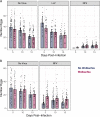Wolbachia protects Drosophila melanogaster against two naturally occurring and virulent viral pathogens
- PMID: 37231093
- PMCID: PMC10212958
- DOI: 10.1038/s41598-023-35726-z
Wolbachia protects Drosophila melanogaster against two naturally occurring and virulent viral pathogens
Abstract
Wolbachia is a common endosymbiont that can protect insects against viral pathogens. However, whether the antiviral effects of Wolbachia have a significant effect on fitness remains unclear. We have investigated the interaction between Drosophila melanogaster, Wolbachia and two viruses that we recently isolated from wild flies, La Jolla virus (LJV; Iflaviridae) and Newfield virus (NFV; Permutotetraviridae). Flies infected with these viruses have increased mortality rates, and NFV partially sterilizes females. These effects on fitness were reduced in Wolbachia-infected flies, and this was associated with reduced viral titres. However, Wolbachia alone also reduces survival, and under our experimental conditions these costs of the symbiont can outweigh the benefits of antiviral protection. In contrast, protection against the sterilizing effect of NFV leads to a net benefit of Wolbachia infection after exposure to the virus. These results support the hypothesis that Wolbachia is an important defense against the natural pathogens of D. melanogaster. Furthermore, by reducing the cost of Wolbachia infection, the antiviral effects of Wolbachia may aid its invasion into populations and help explain why it is so common in nature.
© 2023. The Author(s).
Conflict of interest statement
The authors declare no competing interests.
Figures



References
-
- Werren JH, Windsor D, Guo LR. Distribution of Wolbachia among neotropical arthropods. Proc. R. Soc. Lond. Ser. B Biol. Sci. 1995;262:197–204. doi: 10.1098/rspb.1995.0196. - DOI
Publication types
MeSH terms
Substances
LinkOut - more resources
Full Text Sources
Molecular Biology Databases

